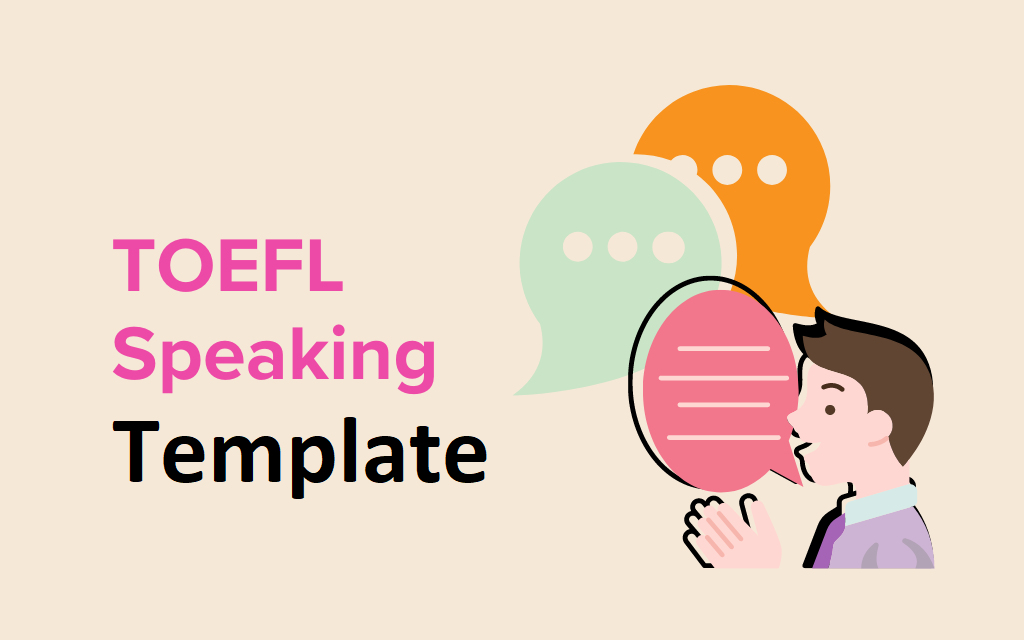The TOEFL (Test of English as a Foreign Language) is a critical examination for non-native English speakers seeking to study or work in English-speaking countries. A fundamental section of this test is the speaking section, which evaluates a candidate’s ability to communicate effectively in academic and professional settings. Mastering this section is crucial for success on the TOEFL exam. In this article, explained what TOEFL is, TOEFL speaking templates and its benefits.
What Is TOEFL?
TOEFL stands for Test of English as a Foreign Language. It is a standardized test designed to assess the English language proficiency of non-native English speakers who are looking to study, work, or immigrate in English-speaking countries. The TOEFL test measures the ability to understand and use English at the university or college level and is widely accepted by universities, colleges, and organizations around the world as an English language proficiency requirement.

Types of TOEFL Speaking Task
1. TOEFL Speaking Task 1 – Independent Task
Task Description: In this task, you are presented with a personal opinion question and are required to express your own opinion on a given topic. You should provide reasons and examples to support your viewpoint.
Example Prompt: “Some people believe that it is important to always tell the truth, even if it may hurt someone’s feelings. Others believe that it is sometimes better to tell a white lie to avoid hurting someone. Which do you agree with? Explain your opinion and give examples.”
2. TOEFL Integrated Speaking Task 2
Task Description: This task involves listening to an audio recording of a conversation or lecture. After listening, you will be presented with a question that requires you to summarize the main points from the listening material.
Example Prompt: “You will hear a conversation between two students discussing a project for their history class. Summarize the main points of the conversation, and explain how the project will be organized.”
3. TOEFL Integrated Speaking Task 3
Task Description: In this task, you will listen to a conversation between a student and a professor, often related to an academic topic. Your task is to summarize the main points made by the professor and the student’s reaction to those points.
Example Prompt: “Listen to a conversation between a student and a professor about the benefits of studying abroad. Summarize the main points made by the professor, and explain how the student feels about studying abroad and why.”
4. TOEFL Integrated Speaking Task 4
Task Description: This task involves listening to an academic lecture or discussion. After listening, you will be presented with a question that asks you to summarize the main points of the lecture and how they relate to a related topic presented in reading material.
Example Prompt: “You will hear a lecture about the impact of climate change on wildlife. Summarize the main points of the lecture and explain how they are related to the information presented in the reading passage.”
The TOEFL Speaking Template
The TOEFL Speaking Template serves as a structured roadmap, aiding candidates in delivering well-organized and coherent responses for each speaking task.
TOEFL Speaking Task 1 Template
Task Description: In this task, you will be presented with a campus situation and will be required to respond based on the information provided.
Time Limit: You will have 45 seconds to prepare your response, and then you will have 45 seconds to speak.
Situation: You will hear a short conversation between two people, typically a student and a campus staff member. They will discuss a campus-related issue or event.
Instructions for Your Response:
- Listen Carefully: Pay close attention to the conversation. Take notes if necessary.
- Prepare: During the 45-second preparation time, organize your thoughts. You should consider the following:
- What is the issue or event being discussed?
- What are the main points made by the speakers?
- What is the student’s opinion or request?
- What is the staff member’s response or suggestion?
- Respond Clearly: When it’s your turn to speak, begin by summarizing the main points of the conversation. You should include:
- A brief introduction of the situation and the people involved.
- The issue or event being discussed.
- The student’s opinion or request.
- The staff member’s response or suggestion.
- Express Your Opinion: After summarizing, share your own opinion or suggestion regarding the situation. You can agree or disagree with the student’s viewpoint or provide additional insights.
- Support Your Response: Use specific details and examples to support your opinion. Draw from your own knowledge and experiences if relevant.
- Conclude: Wrap up your response by summarizing your main points and reiterating your opinion or suggestion.
Remember to speak clearly, concisely, and confidently. Make the best use of the 45 seconds you have to respond.
Scoring Criteria: You will be evaluated on the following aspects:
- Your ability to accurately summarize the conversation.
- The clarity and coherence of your response.
- The relevance and depth of your own opinion and supporting details.
- Your language proficiency, including vocabulary and pronunciation.
TOEFL Speaking Task 2 Template
Task Description: In this task, you will be asked to express your opinion on a given topic. You will need to provide reasons and examples to support your viewpoint.
Time Limit: You will have 15 seconds to prepare your response, and then you will have 45 seconds to speak.
Topic: The examiner will present you with a topic or question. This could be related to personal experiences, current events, or general knowledge.
Instructions for Your Response:
- Listen Carefully: Pay close attention to the topic or question presented by the examiner.
- Prepare: During the 15-second preparation time, brainstorm your response. Consider the following:
- Your opinion on the topic (whether you agree or disagree).
- Key reasons or examples to support your opinion.
- A basic structure for your response (introduction, reasons, examples, conclusion).
- Respond Clearly: When it’s your turn to speak, begin with a clear and concise introduction where you state your opinion on the topic.
- Provide Reasons: In the body of your response, elaborate on the reasons behind your opinion. You should aim to provide 2-3 strong reasons, each followed by specific examples or details to illustrate your point.
- Use Transition Words: Use transition words (e.g., “firstly,” “secondly,” “in addition,” “however”) to connect your ideas and make your response coherent.
- Conclude: Summarize your main points and restate your opinion in a concluding statement.
Remember to speak clearly, stay on topic, and manage your time effectively within the 45-second response window.
Scoring Criteria: You will be evaluated on the following aspects:
- Your ability to express a clear opinion on the topic.
- The quality and relevance of your reasons and examples.
- The overall coherence and organization of your response.
- Your language proficiency, including vocabulary and pronunciation.
TOEFL Speaking Task 3 Template
Task Description: In this task, you will be required to listen to a conversation or lecture related to an academic topic and then provide a summary of the main points and the relationship between them.
Time Limit: You will have 30 seconds to prepare your response, and then you will have 60 seconds to speak.
Listening Material: You will hear a conversation between two people or a lecture on a specific academic topic. This material will contain key information and ideas.
Instructions for Your Response:
- Listen Actively: Pay close attention to the listening material. Take notes during the conversation or lecture to capture the main points.
- Prepare: During the 30-second preparation time, review your notes and organize your response. Consider the following:
- The main topic or subject of the conversation or lecture.
- The primary points made by the speakers or lecturer.
- How are these points related or connected?
- Respond Clearly: When it’s your turn to speak, provide a clear and concise summary of the main points from the listening material. Be sure to explain the relationship between these points.
- Use Transition Phrases: Use phrases like “first,” “secondly,” “in addition,” “however,” etc., to structure your response and indicate the flow of ideas.
- Avoid Personal Opinions: Stick to summarizing the content and relationships presented in the listening material. Do not express your own opinion.
- Conclude: Wrap up your response by restating the main topic and summarizing the key points and their connections.
Use your 60 seconds wisely to deliver a well-structured summary of the content you heard.
Scoring Criteria: You will be evaluated on the following aspects:
- Your ability to accurately summarize the main points from the listening material.
- The clarity and coherence of your response.
- Your skill in explaining the relationships between the points.
- Your language proficiency, including vocabulary and pronunciation.
Benefits of TOEFL Speaking Templates
Using TOEFL Speaking templates can offer several benefits for test-takers:
- Structure and Organization: Templates provide a structured framework for your responses. They help you organize your thoughts logically and present your ideas in a clear and organized manner, which is crucial for effective communication.
- Time Management: Templates help you manage your time effectively during the TOEFL Speaking section. By following a predefined structure, you can ensure that you allocate an appropriate amount of time to each part of your response, such as the introduction, main points, examples, and conclusion.
- Reduced Anxiety: Knowing that you have a template to follow can help reduce test anxiety. When you have a clear plan in mind, you’re less likely to feel overwhelmed or unsure about how to approach a task.
- Consistency: Templates promote consistency in your responses. This consistency can make it easier for raters to follow your ideas and evaluate your language skills fairly and accurately.
- Clarity: Templates encourage you to use clear and concise language. When you know what information to include in each section of your response, you’re more likely to avoid rambling or getting off-topic.
- Improved Fluency: Practicing with templates can enhance your speaking fluency. As you become more familiar with the structure, you’ll find it easier to transition between different sections of your response, making your speech flow more naturally.
- Better Time Utilization: Templates can help ensure that you cover all the necessary points in your response. This prevents you from forgetting important details or leaving out key elements that could affect your score.
Conclusion
Excelling in the TOEFL speaking section is crucial for non-native English speakers aiming to further their academic or professional aspirations. The TOEFL Speaking Template, as outlined in this article, is a powerful tool to aid test takers in their preparation. Test takers can significantly improve their performance and confidently navigate the TOEFL speaking section by following the step-by-step guide, practising with sample responses, and implementing the suggested tips and strategies. Remember, practice, confidence, and utilizing resources like the TOEFL Speaking Template are crucial to success in this critical examination. Best of luck on your TOEFL journey!

